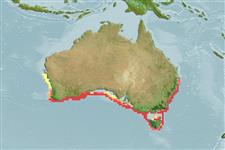Élasmobranches (requins et raies) (sharks and rays) >
Myliobatiformes (Stingrays) >
Urolophidae (Round rays)
Etymology: Urolophus: Greek, oura = tail + Greek, lophos = crest (Ref. 45335).
More on author: Macleay.
Environment: milieu / climate zone / depth range / distribution range
Écologie
marin démersal; profondeur 100 - 230 m (Ref. 9863). Temperate; 27°S - 44°S, 112°E - 154°E
Eastern Indian Ocean to Western Pacific: endemic to Australia.
Length at first maturity / Taille / Poids / Âge
Maturity: Lm 50.2, range 45 - 67.5 cm
Max length : 80.0 cm TL mâle / non sexé; (Ref. 9863)
Large offshore bottom stingaree that occurs on the outer continental shelf and uppermost slope (Ref. 9863, 75154).
Life cycle and mating behavior
Maturities | Reproduction | Spawnings | Egg(s) | Fecundities | Larves
Last, P.R. and J.D. Stevens, 1994. Sharks and rays of Australia. CSIRO, Australia. 513 p. (Ref. 6871)
Statut dans la liste rouge de l'IUCN (Ref. 130435)
Menace pour l'homme
Harmless
Utilisations par l'homme
Pêcheries: pêcheries vivrières
Outils
Articles particuliers
Télécharger en XML
Sources Internet
Estimates based on models
Preferred temperature (Ref.
123201): 14.1 - 20.2, mean 15.4 °C (based on 11 cells).
Phylogenetic diversity index (Ref.
82804): PD
50 = 0.5000 [Uniqueness, from 0.5 = low to 2.0 = high].
Bayesian length-weight: a=0.00776 (0.00442 - 0.01365), b=3.10 (2.93 - 3.27), in cm total length, based on LWR estimates for this species & (Sub)family-body (Ref.
93245).
Niveau trophique (Ref.
69278): 3.6 ±0.4 se; based on size and trophs of closest relatives
Fishing Vulnerability (Ref.
59153): Moderate to high vulnerability (52 of 100).
